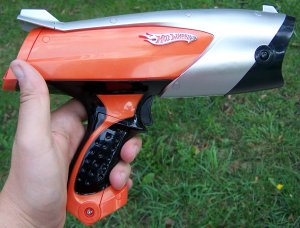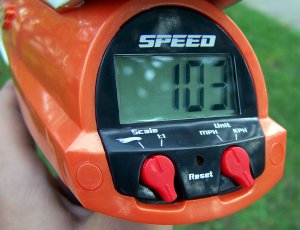 UPDATE (7/20/08) - Please excuse me modifying my post some two years later, but This post sees a lot of traffic. I did more experimentation after I wrote this, for the full review follow this link.
UPDATE (7/20/08) - Please excuse me modifying my post some two years later, but This post sees a lot of traffic. I did more experimentation after I wrote this, for the full review follow this link.I just bought a Hot Wheels Radar Gun to see if it was at all useful in physics or physical science. The radar gun is hand-held. While it was designed for smaller hands than mine (go figure, 35 year old physics teachers aren't the target audience) it is still easy enough to hold and use. You have two unit settings kph and mph and you have the choice of getting straight speed or hotwheels car scale speed (1:64). I've of course been working in scale speed so I can be more precise (hopefully). When you pull the trigger you get a live readout of speed. When you let go it reports the maximum speed measured.
Experiment #1: Determining g using a falling object (a book)
- I held the radar gun above the book pointed down
- The book is held 2 m off the ground and dropped
- Velocity is taken in kph with the scale speed setting (1:64)
- Result - using the equation a=(v^2)/(2d) I get a value of 5.16 m/s/s. Only about a 47% error. (were shooting for 9.8 m/s/s)

- If the book drifts out of the radar beam I don't get really big numbers. I've done this same experiment using Vernier motion sensors and if your target moves out of the "beam" the floor is shot given the impression that the object "teleported" instantaneously to the floor resulting in a really big velocity.
- The results are the same if the object is held really close to the gun as they are if you start further away. The Vernier motion sensor can't get a reading within 0.5 m or so.
- It was really hard to get consistent results. Tow out of three results would be the same, but the third would be wildly different.
- The "reaction time" of the gun may be slow. This would explain the lack of teleportation velocity and may explain why I never got a true value for the maximum velocity of my falling object. It may very well be that the gun doesn't work well with accelerating objects and will give me more consistent results with constant velocity objects.
- Next step - Try known constant velocity experiment.
- Read GPS unit wile attempting to not fall off and not run my son down (while going between 8 and 9 mph).
- My son shoots me with the radar gun staying in my path just long enough to get a good reading before diving to safety.
- Compare the results.
- The results are much more consistent than in Experiment #1.
- The numbers from the GPS unit and radar gun are fairly similar. It's tough to get a good reading from the GPS unit while not running my son down.
- My inital conclusions seem to be confirmed. A constant velocity seems to give a better answer. There was a 13% error between the radar gun and the GPS velocities. While this seems like a lot, I am not really concerned. I know neither the error rate of the radar gun nor the error in the velocity estimate of the GPS unit. The error inherent in both devices may be compounded. It is impossible to know without further testing.
- The radar gun may in fact be not too bad. After the first experiment I wasn't so sure.
Technorati Tags: Probeware, Vernier, Motion, toys, education, falconphysics


13 comments:
I have also used this gun to measure the speed of my RC car.However,I recieved a constant readout of 110 mph.I had it set to 1:1 and mph and I know my car is fast but I just didn't expect such high speeds.Am I not reading it right?My car is a 1/18 scale car so I don't know if there is a diferent way of determing real size speeds.Could you please help?
I doubt the RC car is traveling 110 mph. If I were you I'd check you radar gun against a known speed. Say an actual car going down your street. Just be very careful to stay out of the street so you won't get hit.
In order to calculate scale speed you would simply multiply the actual speed by the scale factor. In your case that would be (110 mph)*18 yielding a scale speed of 1980 mph.
Yes,I did check the radar guns accuracy with my own vehicle and it was 1 mph off.I guess my car is just crazy fast.LOL.Thanks for the reply.
OK, Teach. Explain experiment #1 to me, if you'd be so kind. How can you make a velocity reading on an object under constant acceleration? You didn't specify the position of the book at the instant(?) of reading. Unless this radar gun has some fancy averaging circuit, you're just reading velocity at an arbitrary point. And your formula calculates the velocity at impact, which should be 6.26 m/s, not 9.8.
When you hold the trigger down you read the instantaneous velocity. After the trigger is released you are left with a reading of the maximum velocity (according to the instructions).
I was hoping that I'd be able to plug the maximum velocity into the equation for conservation of energy and then arrive at the acceleration due to gravity.
Unfortunately, I was apparently not reading the true maximum velocity. I'm still not sure how quickly the gun is able to determine the speed of a moving object. Although I'm pondering a methodology for experimentally determining it...
Hopefully this answers your question, if not please don't hesitate to ask again.
We are wanting to use this Hot wheels radar gun to measure the speed of my sons pitching. We bought the gun on ebay and it came with no directions or books. What settings do you recommend and where should we be standing to get the best results behind him or in front of him. Thanks so much for your feed back.
What do you think of using this radar gun to measure the speed of a baseball?
Should it be placed behind the pitcher or in front of at the batters position?
I can do either one, but reading your experiments, it doesn't seem like it'll work.
Please let me know
thanks
If you're measuring the speed of a ball, it will be best to have the ball traveling directly at you. Therfore, stand behind the catcher and hope that your son is accurate :)
What velocity reading did you get in Experiment 1? 4.54m/s?
The gun takes a series of instantaneous (averaged over a short span) readings. There is no guarantee that the last reading corresponds to the instant the book hit the floor. It could have been taken when it was a foot off the deck. In that case, the highest (consistent)reading would be one that just happened to be nearest the floor.
http://www.scantool.net/
For $50 you can read your cars real time speed , which I have found to be more correct , more in keeping with the gps value of the speed.
Would it work for finding the speed of a friend on a bike or scooter?
Post a Comment